Catholic Customs
 |
 |
 |
 |
 |
 |
 |
Celebrating the Feast of Ss. Peter & Paul
"After the great solemnities of the movable cycle and the feast of St. John the Baptist, none is more ancient, nor more universal in the Church, than that of the two Princes of the Apostles." (The Liturgical Year, vol XII, p. 311)
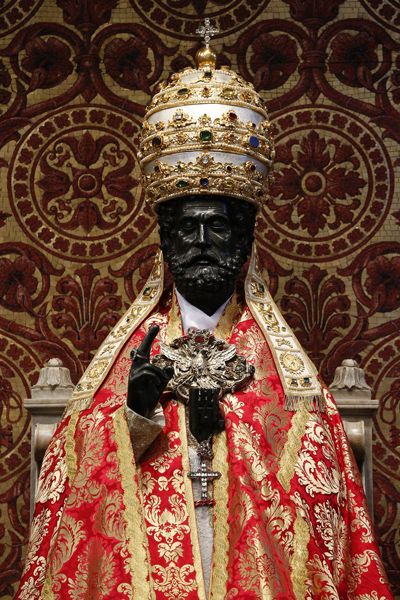 According to tradition, Peter and Paul were both martyred under Emperor Nero on June 29 in the year 64 A.D. in Rome. Peter was crucified upside down in the amphitheater on the Vatican hill; Paul was beheaded outside of the city, a consideration accorded him because he was a Roman citizen.
According to tradition, Peter and Paul were both martyred under Emperor Nero on June 29 in the year 64 A.D. in Rome. Peter was crucified upside down in the amphitheater on the Vatican hill; Paul was beheaded outside of the city, a consideration accorded him because he was a Roman citizen.
Their deaths consecrated the soil of Rome making it the new Jerusalem, the Holy City where the Sovereign Pontiffs would reign. The greatness of these two Apostles was acknowledged by all Catholics from the earliest times and, until recently, this feast day was kept as a holyday of obligation in both the East and the West.
Pious people of the Alpine regions of Europe awaited the Angelus bells on this day to receive special blessings. When the sign of the Cross was made at the conclusion of the Angelus prayer in the early morning of June 29, the kneeling people bowed reverently, believing that the angels brought the Pope's blessing in Rome to all the faithful throughout the world who fervently awaited it on this special day.
In many European countries, many of the customs are simply continuations of the Summer festival season celebrating St. John's Day, which ends at this grand feast. Fireworks light the skies again on this feast, and bonfires are lit in many countries.
In Belgium, a few days before the feast day, Belgian children used to go from farm to farm begging for firewood for the St. Peter fires. While building the great bonfires on the eve of the feast, the people were reminded of the fire by which St. Peter stood when he denied Our Lord thrice. The young people danced around the fire and sang to St. Peter: "St. Peter, come and join us in our circle of joy." (1)
Grand processions
Although there are not a plethora of unique customs for this feast, cities that were under the patronage of St. Peter or St. Paul developed their own marvelous ways to give homage to the great Saints. Throughout Italy, Spain and Portugal the people celebrate with processions, fairs, fireworks and grand displays, but especially in those cities whose patrons are St. Peter or St. Paul.
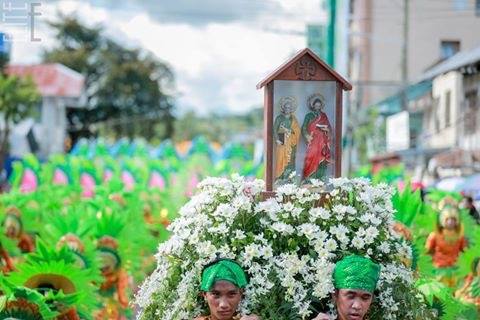 The city that celebrates this feast day with the greatest ardor is Rome, where it has been celebrated since the earliest times. In the evening of June 28, the statue of St. Peter in the Vatican Basilica is dressed in the solemn papal vestments for a special ceremony. During it, the Pope kisses the toe of St. Peter as a solemn act of union with the Rock of the Church.
The city that celebrates this feast day with the greatest ardor is Rome, where it has been celebrated since the earliest times. In the evening of June 28, the statue of St. Peter in the Vatican Basilica is dressed in the solemn papal vestments for a special ceremony. During it, the Pope kisses the toe of St. Peter as a solemn act of union with the Rock of the Church.
In the fourth century, the people processed to St. Peter's to assist at the Pope's pontifical High Mass; afterwards another procession led to the Church of Saint Paul Outside the Walls where the Pope said a second pontifical High Mass. As time passed, the second Mass honoring St. Paul was moved to June 30, because so many pilgrims desired more time for them to be in the two processions.
The feast had a special grandeur before the invasion of electric lights, for in those happy times men set torches and oil lanterns on the Dome of St. Peter's and lit them by jumping from one torch to another until the whole Dome glowed like the sun. (2) Thus did the people give a grand salute to the Princes of the Apostles.
The fishermen's of St. Peter's Day
All across Europe, coastal towns and fishing villages that took St. Peter as their patron had processions, rituals to bless the sea and boats, fairs, and beaches lined with garland-bedecked boats to commemorate the feast. In many of these countries, the fishermen and fishmongers often had the custom of distributing fish to the poor in St. Peter's honor.
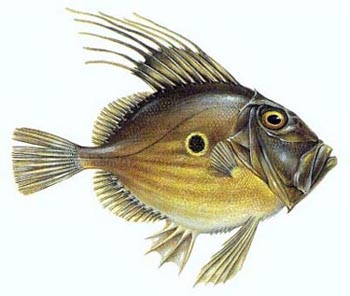 Eating fish in honor of St. Peter was a common custom in many countries. One fish especially suitable for the feast is the John Dory, known as "St. Peter fish" in several languages. This fish was popularly believed to be the one in whose mouth St. Peter had found a coin at the bidding of Our Lord when the temple tax collector demanded payment (Mt 17:24-27). The unique mark on the side of this fish closely resembles a coin, a sign that was imprinted on this fish after the miracle. (3)
Eating fish in honor of St. Peter was a common custom in many countries. One fish especially suitable for the feast is the John Dory, known as "St. Peter fish" in several languages. This fish was popularly believed to be the one in whose mouth St. Peter had found a coin at the bidding of Our Lord when the temple tax collector demanded payment (Mt 17:24-27). The unique mark on the side of this fish closely resembles a coin, a sign that was imprinted on this fish after the miracle. (3)
Belgian fishing villages looked forward to St. Peter's Day, because the Sunday following the feast brought the solemn Blessing of the Sea. After Mass, all mariners, fishermen and other seamen, carrying flowers, garlands and votive offerings, formed a procession led by the clergy to the shore. There the priests boarded boats that carried them out into the sea where they blessed the waves. (4)
On the eve of the feast, Hungarian fishing guilds initiated new boys and masters. In the village of Dunaszekcső, the fishermen walked through the streets carrying a long pole upon which a carp was attached to invite all of the people to the great celebration the following day. To acknowledge the fishermen, the village people would give them cakes and wine. On the feast itself, all of the villagers gathered to enjoy the traditional dish of the day, Harcsapaprikás túróscsuszával (fish paprika with cottage cheese chutney).
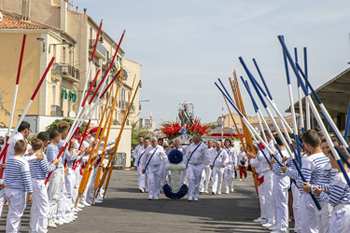 In some Cornish coastal villages, on the eve of the feast, bonfires were lit, fireworks and rockets were set off, and the church towers were illuminated, filling the night with light. Dancing and revelry went far into the night, with the young men competing in leaps through the flames.
In some Cornish coastal villages, on the eve of the feast, bonfires were lit, fireworks and rockets were set off, and the church towers were illuminated, filling the night with light. Dancing and revelry went far into the night, with the young men competing in leaps through the flames.
On the feast day itself, the yearly fair was held with music, feasting, games and gay stalls filled with sweets, toys and other fineries. The fishermen's boats, scrubbed and polished until they shone and adorned with flowers and ribbons, lined the coast. Lively races and feats of seamanship filled the day. Following the competitions, everyone gathered for a grand feast featuring a main course of fish.
In the Italian city of Modica whose patron is St. Peter, the feast is celebrated with a grand evening procession honoring a reliquary of St. Peter and the cherished oak statue of St. Peter healing the paralytic at the gates of the Temple.
 Until 1953, this procession was very solemn with a cortege of 24 saints of colossal stature carried through the torch-lit streets.
Until 1953, this procession was very solemn with a cortege of 24 saints of colossal stature carried through the torch-lit streets.
In the Biscayan fishing village of Lequitio, St. Peter's day dramatic scene is enacted by the men of the Seafarers Confraternity.
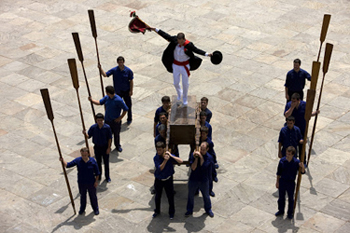 Following a solemn Mass and procession with the image of St. Peter, a man carrying a top hat and a flag painted with St. Peter's keys performs a dance called the kaxarranca on top of a chest carried on the shoulders of eight fishermen. (Pyrenean Festivals, p. 184)
Following a solemn Mass and procession with the image of St. Peter, a man carrying a top hat and a flag painted with St. Peter's keys performs a dance called the kaxarranca on top of a chest carried on the shoulders of eight fishermen. (Pyrenean Festivals, p. 184)
Fairs, grand processions, fireworks and marches are traditional all over Portugal on the Day of Ss. Peter and Paul, but more especially in fishing villages. Portuguese families in the cities display banners and intricately embroidered flags with symbols of the feast from their windows and balconies. The night processions are illuminated with torches, and in the streets the people feast on sardines.
In some areas of Portugal, the children would erect small altars to St. Peter, decorating them with flowers, holy images and candles. Standing by their altars, they asked the passersby to give them a copper "for the poor saint." (6)
St. Paul: the protector of the Harvest
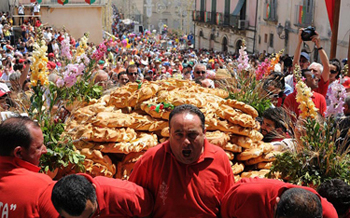
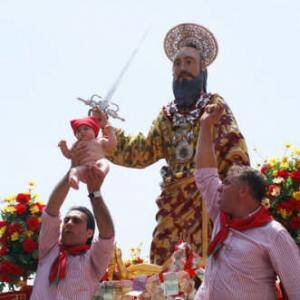 The feast of Ss. Peter and Paul occurs in the beginning of Summer during the harvesting of the wheat. For the Ukrainians, this day marked the beginning of hay making. The
Hungarians symbolically began the wheat harvest on this day with a swing of the scythe, asking for the blessings of St. Peter and Paul.
The feast of Ss. Peter and Paul occurs in the beginning of Summer during the harvesting of the wheat. For the Ukrainians, this day marked the beginning of hay making. The
Hungarians symbolically began the wheat harvest on this day with a swing of the scythe, asking for the blessings of St. Peter and Paul.
In Italy and throughout the Mediterranean lands, the harvesters faced the constant danger of being bitten by poisonous insects or snakes during their work. The Italians were quick to find their remedy in the powerful intercession of St. Paul who was bitten by a viper and unharmed.
In the Italian city of Palazzolo Acreide, there is a very ancient devotion to St. Paul (who became its patron in 1688) that continues to our day – albeit with less piety. At the hour of Terce (9 a.m.), a cart is drawn through the streets to collect large circular loaves of bread (cuddure) decorated with red ribbons and pasta snakes (to recall the protection of St. Paul against poisonous bites).
The cart stops at the church where the loaves are blessed and distributed to the faithful. This bread is cherished and pieces of it are saved to give to friends and family members.
After Mass, the chosen men ceremoniously take the 16th-century statue of St. Paul and place it on a grand vara (statue carrier) with the reliquary containing St. Paul's relics. The vara with its precious statue is triumphantly carried on the shoulders of men of the city. As the statue leaves the church, the church bells ring, the crowd cheers heartily, fireworks are set off, and colorful streamers strewn into the air.
The Catholic zeal that inspired these celebrations ought to burn in our hearts as well, since, in the words of Prudentius: "This day recalls the memory of a triumph most gorgeous: Peter and Paul, both of them victors in death sublime, have ennobled this day with their blood." (The Liturgical Year, vol XII, p. 324)
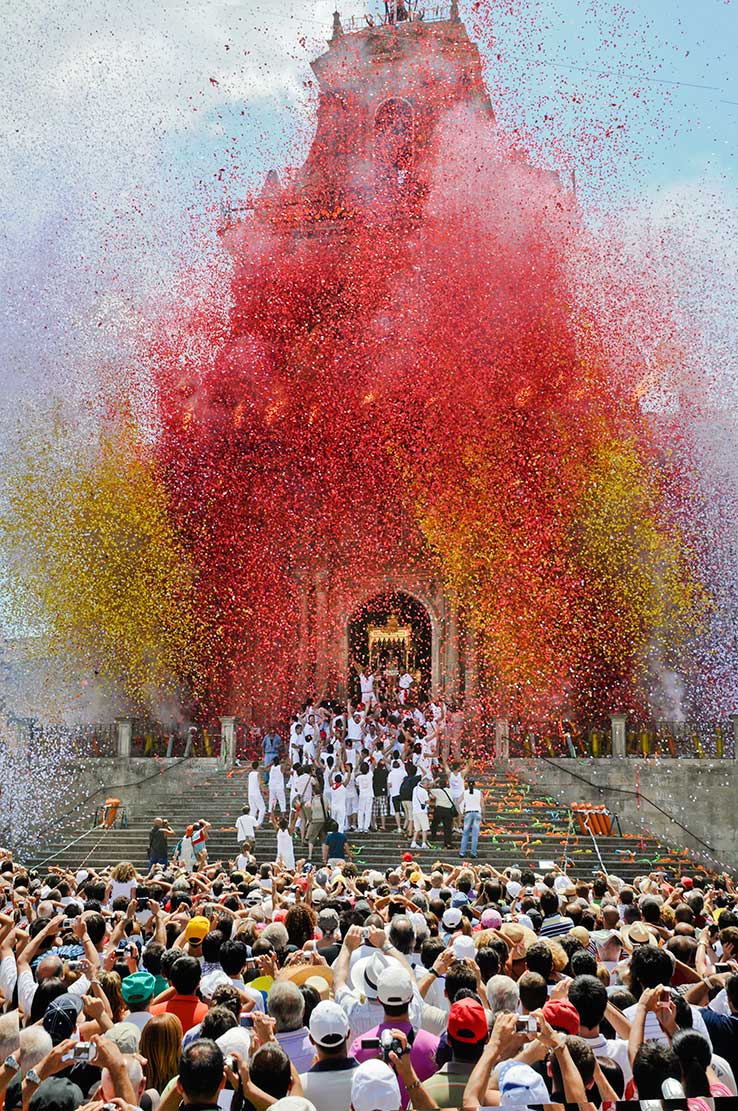

Posted June 28, 2021

St. Peter statue in the Vatican Basilica
in solemn papal vestments
Their deaths consecrated the soil of Rome making it the new Jerusalem, the Holy City where the Sovereign Pontiffs would reign. The greatness of these two Apostles was acknowledged by all Catholics from the earliest times and, until recently, this feast day was kept as a holyday of obligation in both the East and the West.
Pious people of the Alpine regions of Europe awaited the Angelus bells on this day to receive special blessings. When the sign of the Cross was made at the conclusion of the Angelus prayer in the early morning of June 29, the kneeling people bowed reverently, believing that the angels brought the Pope's blessing in Rome to all the faithful throughout the world who fervently awaited it on this special day.
In many European countries, many of the customs are simply continuations of the Summer festival season celebrating St. John's Day, which ends at this grand feast. Fireworks light the skies again on this feast, and bonfires are lit in many countries.
In Belgium, a few days before the feast day, Belgian children used to go from farm to farm begging for firewood for the St. Peter fires. While building the great bonfires on the eve of the feast, the people were reminded of the fire by which St. Peter stood when he denied Our Lord thrice. The young people danced around the fire and sang to St. Peter: "St. Peter, come and join us in our circle of joy." (1)
Grand processions
Although there are not a plethora of unique customs for this feast, cities that were under the patronage of St. Peter or St. Paul developed their own marvelous ways to give homage to the great Saints. Throughout Italy, Spain and Portugal the people celebrate with processions, fairs, fireworks and grand displays, but especially in those cities whose patrons are St. Peter or St. Paul.

Fillipinos process to honor of St. Peter & Paul in Ormoc
In the fourth century, the people processed to St. Peter's to assist at the Pope's pontifical High Mass; afterwards another procession led to the Church of Saint Paul Outside the Walls where the Pope said a second pontifical High Mass. As time passed, the second Mass honoring St. Paul was moved to June 30, because so many pilgrims desired more time for them to be in the two processions.
The feast had a special grandeur before the invasion of electric lights, for in those happy times men set torches and oil lanterns on the Dome of St. Peter's and lit them by jumping from one torch to another until the whole Dome glowed like the sun. (2) Thus did the people give a grand salute to the Princes of the Apostles.
The fishermen's of St. Peter's Day
All across Europe, coastal towns and fishing villages that took St. Peter as their patron had processions, rituals to bless the sea and boats, fairs, and beaches lined with garland-bedecked boats to commemorate the feast. In many of these countries, the fishermen and fishmongers often had the custom of distributing fish to the poor in St. Peter's honor.

The John Dory fish with the mark of a coin on its side
Belgian fishing villages looked forward to St. Peter's Day, because the Sunday following the feast brought the solemn Blessing of the Sea. After Mass, all mariners, fishermen and other seamen, carrying flowers, garlands and votive offerings, formed a procession led by the clergy to the shore. There the priests boarded boats that carried them out into the sea where they blessed the waves. (4)
On the eve of the feast, Hungarian fishing guilds initiated new boys and masters. In the village of Dunaszekcső, the fishermen walked through the streets carrying a long pole upon which a carp was attached to invite all of the people to the great celebration the following day. To acknowledge the fishermen, the village people would give them cakes and wine. On the feast itself, all of the villagers gathered to enjoy the traditional dish of the day, Harcsapaprikás túróscsuszával (fish paprika with cottage cheese chutney).

French fishermen from Sète process carrying a boat with a statue of St. Peter.
On the feast day itself, the yearly fair was held with music, feasting, games and gay stalls filled with sweets, toys and other fineries. The fishermen's boats, scrubbed and polished until they shone and adorned with flowers and ribbons, lined the coast. Lively races and feats of seamanship filled the day. Following the competitions, everyone gathered for a grand feast featuring a main course of fish.
In the Italian city of Modica whose patron is St. Peter, the feast is celebrated with a grand evening procession honoring a reliquary of St. Peter and the cherished oak statue of St. Peter healing the paralytic at the gates of the Temple.

In Modica the traditional procession with St. Peter & fireworks outside the Cathedral at night
In the Biscayan fishing village of Lequitio, St. Peter's day dramatic scene is enacted by the men of the Seafarers Confraternity.

Performing the kaxarranca atop a chest carried on the shoulders of 8 fishermen
Fairs, grand processions, fireworks and marches are traditional all over Portugal on the Day of Ss. Peter and Paul, but more especially in fishing villages. Portuguese families in the cities display banners and intricately embroidered flags with symbols of the feast from their windows and balconies. The night processions are illuminated with torches, and in the streets the people feast on sardines.
In some areas of Portugal, the children would erect small altars to St. Peter, decorating them with flowers, holy images and candles. Standing by their altars, they asked the passersby to give them a copper "for the poor saint." (6)
St. Paul: the protector of the Harvest

Men of Palazzolo Acreide draw the car with the cuddere bread to be blessed; below, holding a baby up to ask for St. Paul's blessing

In Italy and throughout the Mediterranean lands, the harvesters faced the constant danger of being bitten by poisonous insects or snakes during their work. The Italians were quick to find their remedy in the powerful intercession of St. Paul who was bitten by a viper and unharmed.
In the Italian city of Palazzolo Acreide, there is a very ancient devotion to St. Paul (who became its patron in 1688) that continues to our day – albeit with less piety. At the hour of Terce (9 a.m.), a cart is drawn through the streets to collect large circular loaves of bread (cuddure) decorated with red ribbons and pasta snakes (to recall the protection of St. Paul against poisonous bites).
The cart stops at the church where the loaves are blessed and distributed to the faithful. This bread is cherished and pieces of it are saved to give to friends and family members.
After Mass, the chosen men ceremoniously take the 16th-century statue of St. Paul and place it on a grand vara (statue carrier) with the reliquary containing St. Paul's relics. The vara with its precious statue is triumphantly carried on the shoulders of men of the city. As the statue leaves the church, the church bells ring, the crowd cheers heartily, fireworks are set off, and colorful streamers strewn into the air.
The Catholic zeal that inspired these celebrations ought to burn in our hearts as well, since, in the words of Prudentius: "This day recalls the memory of a triumph most gorgeous: Peter and Paul, both of them victors in death sublime, have ennobled this day with their blood." (The Liturgical Year, vol XII, p. 324)

Streamers & fireworks released as St. Paul leaves
the church in Palazzolo Acreide
- Dorothy Gladys Spicer, Festivals of Western Europe (NY: The H. W. Wilson Company, 1958), p 24.
- "29 June: Saints Peter and Paul," Italy Heritage, 1998, June 28, 2021, see here.
- Evelyn Birge Vitz, A Continual Feast (San Fransisco: Ignatius Press, 1985), p. 254.
- Spicer, Festivals of Western Europe, p. 24.
- "Junius 29. Peter-Pal Napja," see here.
- Spicer, Festivals of Western Europe, p. 180.

Posted June 28, 2021
______________________
______________________
 |
 |
 |
 |
 |
 |


